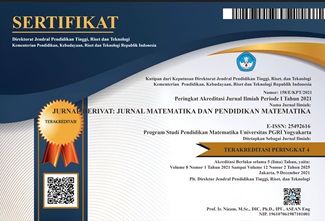Ekplorasi Bahan Ajar Geometri Dalam Kesinambungan Diskursus Matematika
DOI:
https://doi.org/10.31316/j.derivat.v8i1.1332Abstract
This research is an exploration of the implementation of learning geometry mathematics through discourse and aims to get a model of theaching materials as adevelopment of those used by lecturers so far. The research was carried out through questionnaires, direct observation, and discussion of critical discourse analysis and was linked to important needs in mathematicals literacy. Exploration is constructed through theoretical reviews, synthesis from previous research, and examples of development though discourse. The contens of the questionnaire follow the natural discourse of the presentation of theacing materials on the dispotitions of lecturers and students. In particular, the exploration of theaching materials as part of the means of disseminating a culture of mathematics, an aesthetic description of mathematics, and dominant aspecs of lecturers and students. Development road maps are done through centralized examination of discourse, where data tajen from oral and written delivery and from texts that extend views on mathematics and by opening the choice of lectures and students. The result showed the depth of the description of teaching materials without the assumption that curriculum were sufficient to obtain the effectiveness of mathematical literacy and as a more contextual product.
Keywords: theaching material, curriculum, continuity of the discourse of mathematics
References
Aseri, F., Abidin, M.Z., & Wardani. (2014). Kesinambungan dan Perubahan dalam Pemikiran Kontemporer. Jurnal Tashwir, Vol.2 No 3, Juni.
Bair, S.L., & Mooney, E.S. (2013). Mario, Monkey Man, Fish, and Bam-Bam: Creative Terminology in Today’s Classrooms. The Mathematics Teacher, 106, 408-409.
Blanke, B.L. (2009). Understanding Mathematical Discourse in the Elementary Classroom: A Case Study. Disertasi: Oregon State University.
Hamdani. (2015). Meningkatkan Pengetahuan Konseptual dan Pengetahuan Prosedural Mahasiswa Melalui Pendekatan Diskursus Matematik. Jurnal Pendidikan Matematika dan IPA, Vol.6, 13-25.
Hauk, S., Jackson, B., & Noblet, K. (2010). No Teacher Left Behind: Assement of Secondary Mathematics Teachers’ Padagogical Content Knowledge. In S Brown (Ed.), Proceeding for The 13th Conference on Research in Undergraduate Mathematics Education (Electronic).
NCTM (2000). Principle and Standars for School Mathematic. Virginia: NCTM.
Nickerson, S & Bower, J. (2008). Examining Interaction Patterns in College-Level Mathematics Classes: A Case Study. In M. Carlson and C. Rasmussen (Eds), Making the Connection: Research and Association of America.
Ryve, A. (2011). Discourse Research in Mathematics Education. A critical evaluation of 108 journal articles. Journal for Research in Mathematics Education, 42 (2), 167-198.
Scheaffer, R.L. (2008). Scientifically Based Research in Quantitative Literacy: Guidelines for Buliding a Knowledge Base. Numeracy 1 (1): Article 3. https://dx.doi.org/10.5038/1936-4660.1.1.3 (acessed November 10, 2015).
Weber, K. (2004). Traditional Instuction in Advanced Mathematics Courses. A case study of professors’ lectures and proofs in an introductory real analysis course. Journal of Mathematical Behavior, 23 (2), 115-133.
Yackel, E., Ramussen, C., & King, K. (2000). Social and Sociomathematical Norm in an advanced Undergraduate Mathematics Course. Journal of Mathematical Behavior, 19 (3), 275-287.
Downloads
Published
Issue
Section
Citation Check
License
Authors who publish with this journal agree to the following terms:
-
Authors retain copyright and grant the journal right of first publication with the work simultaneously licensed under a Creative Commons Attribution-ShareAlike 4.0 International License that allows others to share the work with an acknowledgment of the work's authorship and initial publication in this journal.
- Authors are able to enter into separate, additional contractual arrangements for the non-exclusive distribution of the journal's published version of the work (e.g., post it to an institutional repository or publish it in a book), with an acknowledgment of its initial publication in this journal.
- Authors are permitted and encouraged to post their work online (e.g., in institutional repositories or on their website) prior to and during the submission process, as it can lead to productive exchanges, as well as earlier and greater citation of published work (See The Effect of Open Access).







